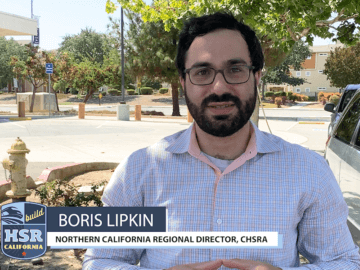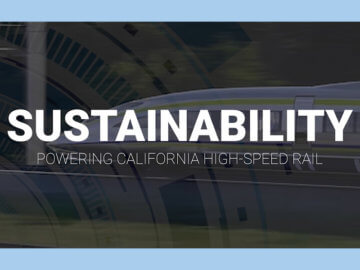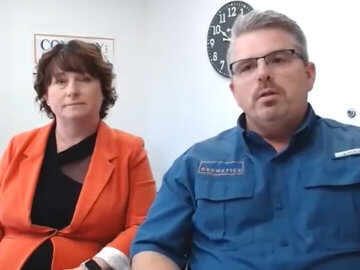Summer 2021 Quarterly Newsletter
|
Statewide News |
Northern California |
Southern California |
Moving Forward at High Speed
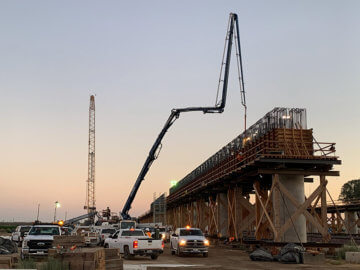
As the final bipartisan federal infrastructure package continues to move forward, over the last few months, we have seen a renewed commitment by elected officials from around the country and here in California towards making clean, green and efficient high-speed rail in the U.S. a reality.
On July 16, U.S. Senator Alex Padilla and Congressman Jim Costa, both of California, took a tour of high-speed rail construction in the Central Valley. They visited the award-winning San Joaquin River Viaduct and Pergola, located just north of the city of Fresno, and met with labor representatives, small business owners and regional economic development leaders. While on tour, Senator Padilla spoke with small business owner Paul Katchadourian. Paul’s company Katch Environmental is one of the more than 600 certified small businesses working on the high-speed rail project. His company has been providing hazardous remediation and demolition services since 2014 on the high-speed rail project.
Senator Padilla also showed his support for this iconic California project by penning a joint letter with Senator Feinstein that urges California’s legislative leaders to allocate the remaining $4.2 billion in voter-approved Proposition 1A bonds that Governor Gavin Newsom is proposing in the state budget. This appropriation will be used to fund currently underway construction work in the Central Valley and will allow the Authority to use the more flexible Cap-and-Trade funds for other program priorities over time. If the Legislature does not appropriate the remaining bond funds, it will result in a shutdown of construction sites in the Central Valley among other impacts. In the letter, the senators say, “Now is not the time for California to step back from its commitment to high-speed rail, a mode of transportation that is critical to reducing congestion and meeting our critically important climate goals.”
In support of ongoing and future high-speed rail projects across the U.S., in a letter earlier this summer to Majority Leader Chuck Schumer, Speaker Nancy Pelosi and other Congressional leaders, a group of elected officials led by Congressman Jim Costa, Congressman Seth Moulton, Congresswoman Alexandria Ocasio-Cortez, and Senators Kristen Gillibrand and Edward Markey called for a carve-out for dedicated high-speed rail funding. This letter of support was co-signed by an additional 75 members of congress including Senators Feinstein, Padilla, Warren and Wyden, and California Representatives Matsui, Garamendi, Khanna, Eshoo, McNerney, Lee, Peters, Brownley, Huffman, Swalwell and Takano. It lays out the economic, environmental and equity benefits a high-speed rail network will bring to America’s transportation network and the development of high-speed rail as a means to create good-paying jobs, foster long-term economic growth and deliver access to more opportunity for smaller communities.
The Authority continues to closely monitor federal action to determine what potential funding opportunities may arise when bill language is final. We appreciate the support as we continue to build the nation’s first high-speed rail project. As usual, California is leading the way.
Proposition 1A Funding Update
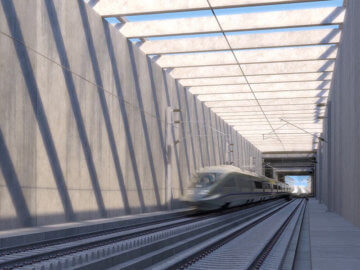
On May 14, Governor Gavin Newsom announced that the remaining $4.2 billion in Proposition 1A funds for high-speed rail were included in the transportation package of the California Comeback Plan. These funds will be used to complete construction in the Central Valley, advance work to launch service between Merced & Bakersfield, and advance planning and project design to connect San Francisco to Los Angeles/Anaheim.
The 2020 Business Plan recommends that $4.1 billion be directed to complete delivery of the 119-mile segment in the Central Valley. The other $100 million would be used for early design and completing environmental review for the full San Francisco to Los Angeles Phase 1 segments. Access to these Proposition 1A funds will also allow the Authority to use the more flexible Cap-and-Trade funds for other program priorities over time.
California voters passed Proposition 1A in 2008, which provided legal guidelines and $9.95 billion in general obligation bonds for the project and related transportation projects, also known as bookend projects. As such, these funds do not come out of the General Fund, nor can those funds be allocated to another project or program.
Since 2017, the Department of Finance has approved four funding plans allowing access to a total of $3.7 billion in Proposition 1A funds. Specifically, $2.6 billion for the Central Valley segment, $600 million for the Caltrain Peninsula Corridor Electrification Project, $77 million for the Rosecrans/Marquardt grade separation project, and $423 million for the Link Union Station (Link US) Project in Los Angeles. With the most recent funding plan in April 2020, the Authority has completed the allocation of all bookend project funding.
As of December 2020, the Authority has expended 99 percent of the authorized $2.6 billion of the Proposition 1A Central Valley segment funds, using the dollars directly for high-speed rail infrastructure. Without the additional $4.2 billion in bond funds, the Authority would be unable to complete construction, be forced to issue pink slips and see construction delays as contracts would have to be wound down and restarted later.
Negotiations for the final transportation package are still on-going between the Governor and legislative leadership. The $3.4 billion in funding for local/regional projects is only possible if subsequent legislative action is taken on the entire transportation package, including the $4.2 billion high-speed rail bond appropriation, or it will revert to the General Fund.
This funding is the first major infusion of State General Fund for transportation in over a decade and will improve the efficiency of transportation systems to make movement around the state safer, faster, and greener:
-
- $400 million for climate adaptation projects to build more resilient infrastructure and address transportation needs related to climate change.
- $500 million to support active transportation by improving safety and access for walking, biking, and mobility options for non-motorized users.
- $500 million to create a safer transportation system by targeting critical safety projects to address high priority grade separations and grade crossings.
- $1 billion to deliver critical projects in advance of the 2028 Olympic games and enhance the state’s transportation system.
- $1 billion to enhance connectivity through clean transportation investment in priority
Authority Board Approves High-Speed Rail Line Between Bakersfield and Palmdale
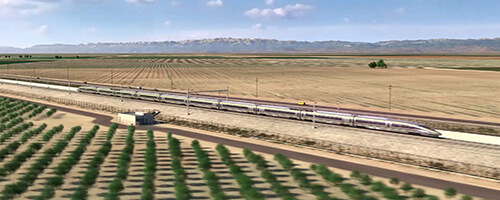
On August 19, the Board agreed to certify the document, clearing the way to add 80 miles to the 199 miles already environmentally cleared on the high-speed rail project, connecting the Central Valley to Southern California’s Antelope Valley in Los Angeles County.
Visit our newsroom to read the full press release.
Joining the Community For 559 Night Market in Fresno’s Chinatown
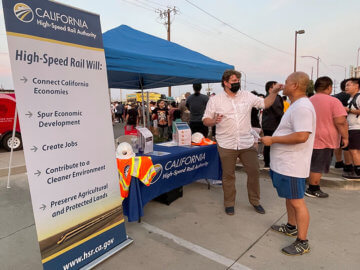
Food trucks and a huge crowd shut down the intersection of Kern and G Street in Fresno’s Chinatown for the first 559 Night Market on July 30. This inaugural event brought more than a dozen food trucks, local vendors and organizations together to showcase what Chinatown has to offer and served as the perfect opportunity to talk about what’s happening just a block away – high-speed rail construction.
California High-Speed Rail Authority (Authority) public information officers (PIOs) Kyle Simerly and Augie Blancas were on hand to talk about the work happening in and around Chinatown, including construction of two underpasses at Ventura and Tulare streets. Both PIOs talked to community members excited about the project and even provided resources and information about how to get jobs on the project.
The 559 Night Market was a pilot collaboration between Fresno Street Eats, local small business Central Fish, the Strategic Growth Council and the Authority.
| Northern California News |
On Track with Bay Area High-Speed Rail: Railway Crossings
Boris Lipkin, Northern California Regional Director for the California High-Speed Rail Authority, talks about the planned high-speed rail crossing at Branham Lane and Monterey Road in South San José.
Hear from Boris in this latest video.
Northern California Quarterly Update
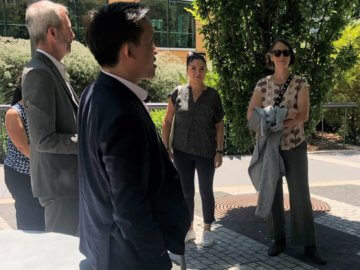 Legislators Tour Bay Area Transit
Legislators Tour Bay Area Transit
In mid-August, Northern California Regional Director Boris Lipkin joined other San Francisco Bay Area transit officials and dignitaries in welcoming Senator Lena Gonzales and Assemblymember Laura Friedman for a 3-day Bay Area transit tour. Senator Gonzalez, who chairs the Senate Transportation Committee, represents the 33rd senate district in Los Angeles County. Assemblymember Gonzales, who chairs the Assembly Transportation Committee, represents the 43rd assembly district, also in Los Angeles County.
The visit was an important opportunity to show key Southern California legislators the vision for the future of transit in Northern California and showcase the critical role high-speed rail will play in the region. BART, Caltrain, the Transbay Joint Powers Authority, San Francisco MTA, Santa Clara Valley Transportation Authority (VTA), AC Transit and the City of San José were among the participants.
Recirculated Draft Environmental Document
In July, the Authority issued a limited revision to its previously published Draft Environmental Impact Report/Supplemental Draft Environmental Impact Statement (Draft EIR/EIS) for the San Francisco to San Jose project section. The recirculated document includes the Millbrae-SFO Station Reduced Site Plan (RSP) Design Variant and an updated evaluation of the monarch butterfly due to recent changes in regulations governing endangered species.
The team in Northern California has been reaching out to the public and stakeholders to inform communities about the new information. Representatives visited Millbrae-SFO Station and the Millbrae Farmers Market to share resources and answer questions. The recirculated materials are available to view and download on the Authority’s website. After the public review and comment period ends on September 8, the Authority will respond to each comment in writing and make necessary adjustments in the EIR/EIS.
Millbrae Community Meeting
Questions, comments, concerns? The California High-Speed Rail Authority staff hosted a virtual community meeting on August 11 to highlight the Millbrae-SFO Station Reduced Site Plan Design Variant and answer questions about the Revised/Supplemental Draft EIR/EIS for the San Francisco to San Jose project section.
The project team provided attendees with an overview of the high-speed rail project development process, highlighting the recirculated document, including a detailed description of the preferred alternative and a design variant for the Millbrae-SFO station. During a lively Q&A session, attendees asked questions about station tracks and platforms, train schedules, and proposed development near the station. The panel provided detailed responses, explaining the differences between the station designs and the technical requirements for high-speed rail service.
The public comment period is open until September 8. Detailed information on the document and how to comment are available on the Authority’s website.
Powering High-Speed Rail with Clean Energy
Morgan Galli, Northern California Deputy Regional Director for the California High-Speed Rail Authority, chats with our Systems Engineering Manager Ryan Scott about designing a sustainable system to power California’s all-electric high-speed rail trains.
See their conversation in this latest video.
Environmental Lab Cultivates Community
 Fashioned from sections of metal tubing entangled with rubber hoses, a leaning tower emits a steady drone. Technicians skillfully tend to the hydraulic drilling machine, withdrawing a core sample from deep underground.
Fashioned from sections of metal tubing entangled with rubber hoses, a leaning tower emits a steady drone. Technicians skillfully tend to the hydraulic drilling machine, withdrawing a core sample from deep underground.
The samples they gather will help engineers on the high-speed rail project determine if the soil is suitable for construction. The results will also identify toxins and contaminants like lead, arsenic and mercury that may be hazardous to people and wildlife.
Torrent Laboratory, Inc., an environmental testing lab in Milpitas in California’s Silicon Valley, provides a broad range of soil testing and other services for transportation agencies.
Mukesh Jani founded the company with a credit card and a conviction. After emigrating from India, he worked as a lab chemist, soon becoming a process engineer and eventually managing a wastewater treatment plant. “To start a lab was a natural thing to do.” he explained, “I saw that there was a market for this kind of facility, particularly for companies that could provide quick-turn services to clients.”
The company was the first lab in the San Francisco Bay Area to offer air analysis. “Initially, we offered wastewater and stormwater services to small industrial clients,” noted Mukesh. “We started expanding into soil testing and then into full-service organic testing.”
Mukesh credits his wife with the company’s success. He said, “She’s my boss, at home and work.” Falguni Jani became employee number two soon after the company formed. As chief financial officer, she led strategic initiatives that transformed a modest 150-square-foot space into a nearly 10,000-square-foot facility.
Since Mukesh’s original idea in 1993, Torrent has flourished and become a premier testing facility. The company holds notable certifications from the National Environmental Laboratory Accreditation Conference (NELAC), State of California, U.S. Department of Defense and U. S. Department of Energy.
Every year, the lab invites high school students to work on intern projects and coordinates with City College of San Francisco to host students from Tokyo. Mukesh sponsors these efforts, “so young people can learn about chemistry and be inspired!”
“We continuously support our community,” he continued. Organizations where sustainability is a priority, such as Habitat for Humanity, receive services at no cost.
Torrent Laboratory, Inc. is passionate about its work and strives to improve the quality of life for everyone. Mukesh concluded, “At the end of the day, everybody in this industry knows that it’s not about the money, it’s about the environment.”
Read more about other small businesses in the August 2021 Small Business Newsletter.
Frequently Asked Questions
Northern California high-speed rail staff respond to many inquiries from residents, local agencies, neighborhood groups, and other stakeholders. Below are answers to some of the more common questions about the program.
How fast will high-speed rail trains travel?
Trains will be capable of speeds of more than 200 miles per hour while making the trip from San Francisco to Los Angeles in under three hours. Travel time from San José to Fresno will be less than an hour. Right now, it takes about two and a half to three hours to drive from San José to Fresno – and that depends on what traffic looks like. Reduced travel time can provide better access to jobs, create new options for affordable housing, and increase workforce development possibilities.
How will high-speed rail interface with existing transit systems, such as BART, Caltrain and Amtrak?
When you look at the stations in Northern California, they are all in places with existing transit connections. High-speed rail stations will serve as more than just a train stop. They will transform cities and create community hubs. That is why we’re calling them station communities.
The future of San José Diridon Station is an example of a multi-agency collaborative project where Caltrain, the City of San José, VTA, MTC, and the Authority have a cooperative agreement to redesign and expand the station as an integrated transit hub.
Have any questions for the NorCal team? Please submit them to us at northern.calfornia@127.0.0.1.
Upcoming Events
Join us at these upcoming events in Northern California. We hope to see you there!
Northern California Town Hall
September 15, 2021
10:00-11:00 a.m.
A virtual town hall featuring a Salesforce Transit Center walking tour and live Q&A from the rooftop park. Click to register for Zoom meeting.
Viva Calle San José
September 19, 2021
10:00 a.m. – 3:00 p.m.
This free program temporarily closes miles of San José streets to bring communities together to walk, bike, skate, play and explore the city. Visit vivacallesj.org for more information.
| Southern California News |
LaDonna’s Corner – A Look Ahead in SoCal for 2021
2021 is turning out to be a significant year for the Authority’s progress in the Southern California region. Three project sections move to the next step in the environmental process, with the Final Environmental Impact Report and Environmental Impact Statement (EIR/EIS) for two project sections, going before the Authority Board of Directors for consideration this year.
Most recently, on June 25, the Bakersfield to Palmdale Project Section Final EIR/EIS became the first project section in Southern California to be published. On August 19, the Board agreed to certify the document, clearing the way to add 80 miles to the 199 miles already environmentally cleared on the high-speed rail project, connecting the Central Valley to Southern California’s Antelope Valley in Los Angeles County. This project section also includes a high-speed station at the city of Palmdale, which will feature a potential connection with the proposed Brightline West high-speed rail service to Las Vegas, via the future High Desert Corridor.
City of Palmdale District 4 Councilmember Juan Carrillo shared his thoughts on this recent milestone. “The City of Palmdale has been working for over 20 years preparing for the arrival of High-Speed Rail (HSR) in Palmdale. Approval of the Bakersfield to Palmdale EIR is yet another significant positive step that will help establish a path forward that will eventually lead to connecting Palmdale/Antelope Valley to the entire state, and beyond, by way of high-speed rail. We look forward to the day when HSR will integrate with other modes of transportation at our future multi-modal high-speed rail train station in downtown Palmdale. We are currently in the early stages of planning and designing our station. I am supportive of high-speed rail as it will reduce air pollution, provide transportation options for our commuting population, and transform the way our residents live, work and play.”
Stay tuned as 2021 continues with other notable steps forward in the region with the release of the Palmdale to Burbank Draft EIR/EIS anticipated in the fall, and the release of the Burbank to Los Angeles Final EIR/EIS toward the end of the year.
Check the Authority’s website for information on the four project sections in the Southern California region and how to provide public comment when the Palmdale to Burbank Draft EIR/EIS is released. You can also sign up for email updates on any section. The website also provides a link to BuildHSR.com showing construction progress that has created more than 5,500 new jobs on this transformative statewide project.
View LaDonna’s video at https://youtu.be/BuRooqc7t_8.
Palmdale to Burbank – A Look Ahead – Connecting Two Key Population Centers
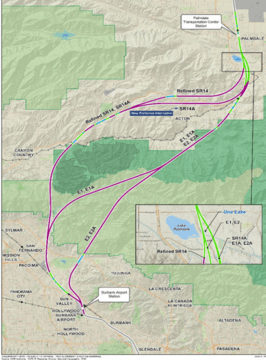
In the fourth quarter 2021, the California High-Speed Rail Authority (Authority) anticipates issuing the Draft Environmental Impact Report/Environmental Impact Statement for the Palmdale to Burbank Project Section. The Palmdale to Burbank Project Section will connect the Antelope Valley to the San Fernando Valley, which will bring high-speed rail service to the urban Los Angeles area with a new modern rail line that dramatically reduces travel time between the Antelope Valley and the Los Angeles Basin.
This project section will connect two key population centers in Los Angeles County with multi-modal transportation hubs at the Palmdale Transportation Center and Hollywood Burbank Airport Station.
These station locations will provide an additional link between the Antelope Valley, the Los Angeles basin, the state at large and the rest of the U.S. through eventual connections to the Hollywood Burbank Airport and other high-speed trains.
The City of Palmdale and the Authority are currently working together to develop a station area plan that will help the City promote economic development, encourage station area development and enhance connectivity to other modes of transportation.
Upon completion, the Palmdale to Burbank Project Section will:
- Provide a new link between Central and Southern California and the statewide transportation network;
- Connect the Palmdale Transportation Center to the Hollywood Burbank Airport Station with an approximately 25-minute high-speed rail trip;
- Provide new opportunities for economic development and connections to many destinations and transportation options;
- Connect high-speed rail to the region via existing and planned Metrolink stations; and
- Provide connection opportunity in Palmdale to the Brightline West high-speed trains between Las Vegas and Los Angeles.
High-Speed Rail, City of Palmdale Partner to Advance Palmdale Station Planning
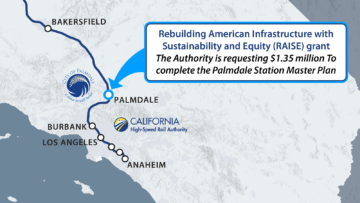
The California High-Speed Rail Authority (Authority) took another step toward advancing work for the proposed high-speed rail station in downtown Palmdale. The Authority entered into an agreement July 12 with the City of Palmdale to supply matching funds for a grant application to the U.S. Department of Transportation’s (USDOT) Rebuilding American Infrastructure with Sustainability and Equity (RAISE) program. If awarded, the grant will support completion of the city’s Station Implementation Master Plan (Master Plan).
The Authority is requesting a $1.35 million RAISE grant to fund development of the Master Plan for the integrated, multimodal future Palmdale high-speed rail station which is expected to improve transit performance and connectivity. The RAISE funding would enable the Authority, in close collaboration with the City of Palmdale, to advance conceptual design work of a world-class rail and transit center in downtown Palmdale.
The Palmdale Station will serve as a connection point for California high-speed rail, Southern California Regional Rail Authority (Metrolink) and Brightline West, creating a seamless connection between California’s high-speed rail system and Brightline’s planned high-speed rail service to Las Vegas via Palmdale. Multiple agencies, including Los Angeles County Metropolitan Transportation Authority (Metro), High Desert Corridor Joint Powers Authority and the Antelope Valley Transit Authority, are collaborating on the station.
The total cost of the project is estimated to be $1.8 million, with a commitment of $250,000 from the Authority and another $200,000 from the City of Palmdale. The USDOT’s RAISE Grant applications are evaluated based on safety, environmental sustainability, quality of life, economic competitiveness, state of good repair, innovation and partnership.
The Authority’s San Francisco to Los Angeles/Anaheim Phase 1 high-speed rail system is currently under construction in the Central Valley along 119 miles at 35 different construction sites with an average of 1,100 workers daily. For more on construction progress visit BuildHSR.com.
High-Speed Rail Work Helps Conaway Geomatics Keep Doors Open During Pandemic
The husband-and-wife team of Shannon and Cossette Conaway own the Southern California firm based in Placentia. Their firm is helping clear creating plat and legal reports to finalize ownership of land acquired for the California High-Speed Rail Authority. The full-service geospatial firm provides land surveying and GIS services to many other clients.
Hear from Shannon and Cossette what working on high-speed rail has meant to their business.
LA Metro’s TCAP Invites Authority to Speak to Summer Interns
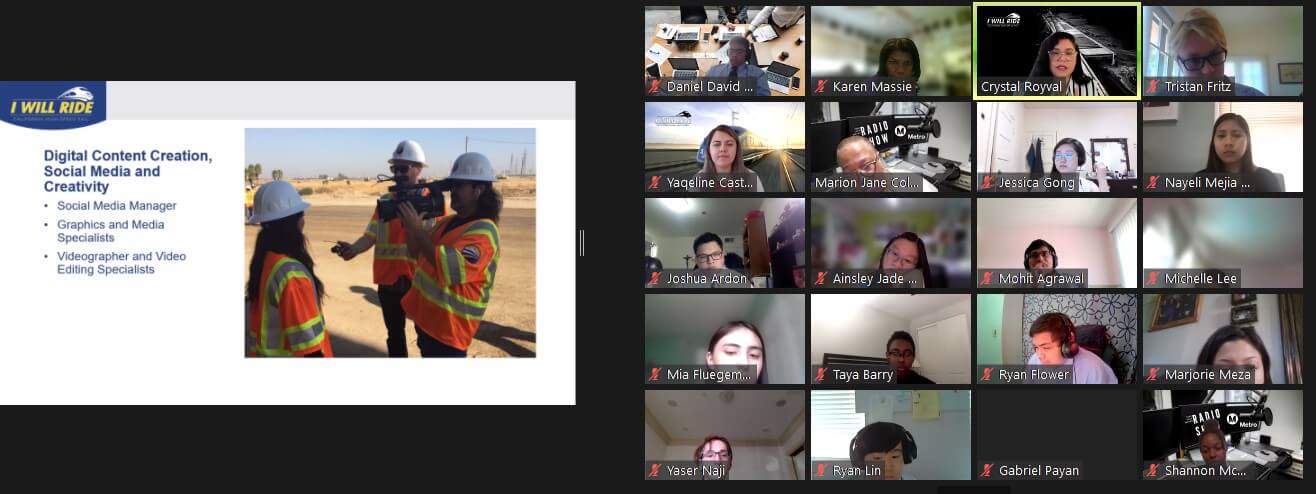
On July 23, Yaqeline Castro, Student Outreach Liaison and Crystal Royval, Public Information Officer in the Southern California Region, joined LA Metro’s Transportation Career Academy Program (TCAP) to speak with students about a career in government communications and provide a project update on California’s high-speed rail During the presentation, the students learned about a variety of careers in communications on a statewide mega project like high-speed rail. The TCAP interns and program leads were joined by various staff from the California High-Speed Rail Authority’s (Authority) communications team who helped answer questions and share the impactful experiences their career in communications has provided them.
The TCAP summer interns are junior and senior high school students who reside in Los Angeles County, are part of communities in close proximity of a LA Metro Rail station and/or expansion project, are transit dependent and have a strong interest in pursuing a career in transportation. The student interns were put into teams and provided a seasoned mentor to work on-the-job and gain real-world work experience in a specific career pathway or in a particular technical area of their interest.
Thank you, LA Metro, for inviting the Authority to speak to your interns!
Quarterly Newsletter Archive
- Spring 2023 All Aboard Newsletter
- Winter 2023 Quarterly Newsletter
- Fall 2022 Quarterly Newsletter
- Summer 2022 Quarterly Newsletter
- Spring 2022 Quarterly Newsletter
- Winter 2022 Quarterly Newsletter
- Fall 2021 Quarterly Newsletter
- Summer 2021 Quarterly Newsletter
- Regional Newsletter - May 2021
- Regional Newsletter - February 2021
- Regional Newsletter - November 2020
- Regional Newsletter - August 2020
- Regional Newsletter - June 2020
- Regional Newsletter - February 2020
- Regional Newsletter - November 2019
- Regional Newsletter - August 2019
The California High-Speed Rail Authority makes every effort to ensure the website and its contents meet mandated ADA requirements as per the California State mandated Web Content Accessibility Guidelines 2.0 Level AA standard. If you are looking for a particular document not located on the California High-Speed Rail Authority website, you may make a request for the document under the Public Records Act through the Public Records Act page. If you have any questions about the website or its contents, please contact the Authority at info@127.0.0.1.


